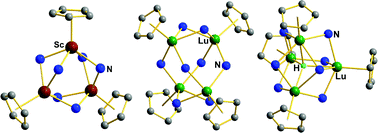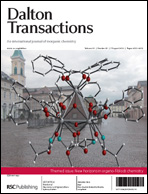The scandium dialkyl complex [Cp′Sc(CH2SiMe3)2(THF)] (1-Sc, Cp′ = C5Me4SiMe3) reacts rapidly with ammonia at room temperature to afford selectively a trinuclear hexaamido complex [Cp′Sc(μ-NH2)2]3 (3-Sc) with release of SiMe4. The reaction of the lutetium dialkyl complex [Cp′Lu(CH2SiMe3)2(THF)] (1-Lu) with ammonia under the same conditions gives the analogous hexaamido Lu complex [Cp′Lu(μ-NH2)2]3 (3-Lu) as a major product (92%) together with a tetranuclear octaamido complex [Cp′Lu(μ-NH2)2]4 (4-Lu) as a minor product (8%). In contrast, reaction of tetranuclear rare-earth metal octahydride complexes [Cp′Ln(μ-H)2]4(THF) (Ln = Y (2-Y), Lu (2-Lu)) with ammonia under similar conditions yields selectively the heptaamido/monohydrido complexes [(Cp′Ln)4(μ-NH2)6(μ3-NH2)(μ4-H)] (Ln = Y (5-Y), Lu (5-Lu)), in which a μ4-H ligand remains at the center of the tetrahedral metal framework. Exposure of heptaamido/monohydrido complex 5-Lu to an ammonia atmosphere at room temperature for a long time (two days) affords the octaamido complex 4-Lu quantitatively. The molecular structures of 3-Sc, 3-Lu, 4-Lu, 5-Y, and 5-Lu have been determined by X-ray analyses.

You have access to this article
 Please wait while we load your content...
Something went wrong. Try again?
Please wait while we load your content...
Something went wrong. Try again?


 Please wait while we load your content...
Please wait while we load your content...